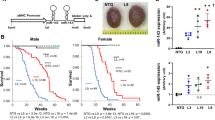Abstract
Although the 150 kDa oxygen-regulated protein (ORP150) is known as a protein induced by low oxygen tension or ischemical insult, its possible role has not been fully investigated in vivo. To investigate the intracellular function of this protein, we generated the ORP150 over-expressing transgenic mice (ORP-Tg mice) under β-actin promoter, and established three independent lines of the transgene expressed mice. All lines invariably showed growth retardation. Over-expression of ORP150 was confirmed by western blotting in heart, brain, spleen, skeletal muscle, pancreas, lung, thymus, and kidney. To ascertain the relationship between the over-expression of the ORP150 and the growth retardation in the transgenic mice, we examined pathological changes in the transgenics. In the ORP-Tg mice, vacuolar degeneration appeared in the heart. The degeneration in the myocytes became conspicuous with advancing age. Immunostaining demonstrated ORP150 in the vacuoles of degenerating myocytes. Electron microscopical findings revealed striking development of intracellular membrane system, for example, rough endoplasmic reticula (rER), vacuoles and Golgi bodies, swelling of sarcoplasmic reticulum, and lysis of myofibrils and mitochondria. These findings indicate that ORP150 may locate in the rER and other outer compartment of ER, and that constitutive over-expression of ORP150 in the heart induces vacuolar degeneration in myocytes, resulting in growth retardation of the transgenics.
Similar content being viewed by others
References
Brinster RL, Chen HY, Trumbauer ME, Yagle MK and Palmiter RD (1985) Factors affecting the efficiency of introducing foreign DNA into mice by microinjecting eggs. Proc Natl Acad Sci USA 82: 4438–4442.
Chen X, Easton D, Oh HJ, Lee-Yoon DS, Liu X and Subjeck J (1996) The 170 kDa glucose regulated stress protein is a large HSP70-, HSP110-like protein of the endoplasmic reticulum. FEBS Lett 380: 68–72.
Heacock CS and Sutherland RM (1986) Induction characteristics of oxygen regulated proteins. Int J Radiat Oncol Biol Phys 12: 1287–1290.
Ikeda J, Kaneda S, Kuwabara K, Ogawa S, Kobayashi T and Matsumoto M et al. (1997) Cloning and expression of cDNA encoding the human 150 kDa oxygen-regulated protein, ORP150. Biochem Biophys Res Commun 230: 94–99.
Kobayashi T, Ogawa S, Yura T and Yanagi H (2000) Abundant expression of 150-kDa oxygen-regulated protein in mouse pancreatic beta cells is correlated with insulin secretion. Biochem Biophys Res Commun 267: 831–837.
Kuwabara K, Matsumoto M, Ikeda J, Hori O, Ogawa S and Maeda Y et al. (1996) Purification and characterization of a novel stress protein, the 150-kDa oxygen-regulated protein (ORP150), from cultured rat astrocytes and its expression in ischemic mouse brain. J Biol Chem 271: 5025–5032.
Lin HY, Masso-Welch P, Di YP, Cai JW, Shen JW and Subjeck JR (1993) The 170-kDa glucose-regulated stress protein is an endoplasmic reticulum protein that binds immunoglobulin. Mol Biol Cell 4: 1109–1119.
Lin BL, Wang JS, Liu HC, Chen RW, Meyer Y and Barakat A et al. (2001) Genomic analysis of the Hsp70 superfamily in Arabidopsis thaliana. Cell Stress Chaperones 6: 201–208.
Llewelyn Roderick H, Llewellyn DH, Campbell AK and Kendall JM (1998) Role of calreticulin in regulating intracellular Ca2+ storage and capacitative Ca2+ entry in HeLa cells. Cell Calcium 24: 253–262.
Marber MS, Mestril R, Chi SH, Sayen MR, Yellon DM and Dillmann WH (1995) Overexpression of the rat inducible 70-kDa heat stress protein in a transgenic mouse increases the resistance of the heart to ischemic injury. J Clin Invest 95: 1446–1456.
Nakamura K, Robertson M, Liu G, Dickie P, Guo JQ and Duff HJ et al. (2001) Complete heart block and sudden death in mice overexpressing calreticulin. J Clin Invest 107: 1245–1253.
Naved AF, Ozawa M, Yu S, Miyauchi T, Muramatsu H and Muramatsu T (1995) CBP-140, a novel endoplasmic reticulum resident Ca(2+)-binding protein, with a carboxy-terminal NDEL sequence showed partial homology with 70-kDa heat shock protein (hsp70). Cell Struct Funct 20: 133–141.
Niwa H, Yamamura K and Miyazaki J (1991) Efficient selection for high-expression transfectants with a novel eukaryotic vector. Gene 108: 193–199.
Okabe M, Ikawa M, Kominami K, Nakanishi T and Nishimune Y (1997) 'Green mice' as a source of ubiquitous green cells. FEBS Lett 407: 313–319.
Ozawa K, Kuwabara K, Tamatani M, Takatsuji K, Tsukamoto Y and Kaneda S et al. (1999) 150-kDa oxygen-regulated protein (ORP150) suppresses hypoxia-induced apoptotic cell death. J Biol Chem 274: 6397–6404.
Ozawa K, Kondo T, Hori O, Kitao Y, Stern DM and Eisenmenger W et al. (2001) Expression of the oxygen-regulated protein ORP150 accelerates wound healing by modulating intracellular VEGF transport. J Clin Invest 108: 41–50.
Plumier JC, Ross BM, Currie RW, Angelidis CE, Kazlaris H and Kollias G et al. (1995) Transgenic mice expressing the human heat shock protein 70 have improved post-ischemic myocardial recovery. J Clin Invest 95: 1854–1860.
Saito Y, Ihara Y, Leach MR, Cohen-Doyle MF and Williams DB (1999) Calreticulin functions in vitro as a molecular chaperone for both glycosylated and non-glycosylated proteins. EMBO J 18: 6718–6729.
Tamatani M, Matsuyama T, Yamaguchi A, Mitsuda N, Tsukamoto Y and Taniguchi M et al. (2001) ORP150 protects against hypoxia/ ischemia-induced neuronal death. Nat Med 7: 317–323.
Tsukamoto Y, Kuwabara K, Hirota S, Ikeda J, Stern D and Yanagi H et al. (1996) 150-kDa oxygen-regulated protein is expressed in human atherosclerotic plaques and allows mononuclear phagocytes to withstand cellular stress on exposure to hypoxia and modified low density lipoprotein. J Clin Invest 98: 1930–1941.
Tsukamoto Y, Kuwabara K, Hirota S, Kawano K, Yoshikawa K et al. (1998) Expression of the 150-kDa oxygen-regulated protein in human breast cancer. Lab Invest 78: 699–706.
Author information
Authors and Affiliations
Corresponding author
Rights and permissions
About this article
Cite this article
Kobayashi, T., Ohta, Y. Enforced Expression of Oxygen-Regulated Protein, ORP150, Induces Vacuolar Degeneration in Mouse Myocardium. Transgenic Res 12, 13–22 (2003). https://doi.org/10.1023/A:1022176004928
Issue Date:
DOI: https://doi.org/10.1023/A:1022176004928




